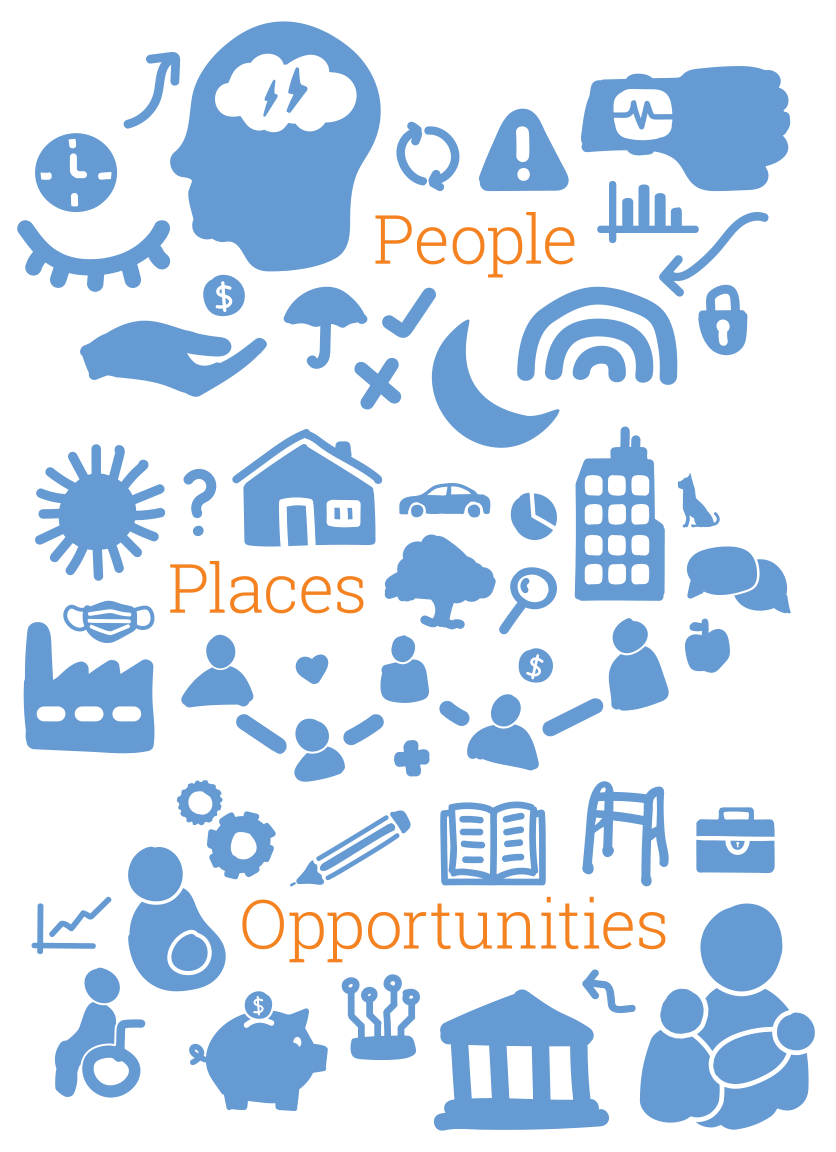Conceptual framework
Our decision to organise our new program of research into the three program areas of People, Places, and Opportunities responds to the elements that collectively constitute an individual’s lived experience at any point in time. These elements contribute to persistent deep disadvantage and are also the core ingredients for improvement. At key life course transitions (e.g. parenthood, marriage), each are malleable to positive and negative disruptors (e.g. financial insecurity, job changes) and exposure to external elements beyond individual control (e.g. neighbourhoods, industry closures).
Through these interrelated programs of work, the Centre tackles a grand challenge in the study of deep and persistent disadvantage: how do we support children and families to exit disadvantage when their community contexts require highly situational responses and their life chances are subject to unequal opportunity structures?
Research program 1
1.1 Cognitive Science of Disadvantage:
Predicting how the duress of disadvantage affects individual decisions and drives predictable biases.
1.2 Financial Choices through the Life Course:
Defining financial attitudes and behaviours that are associated with entering and exiting disadvantage.
1.3 Social Determinants of Sleep:
Interpreting sleep and circadian function as an index of social disadvantage and a driver of inequality in cognitive processing.
People
Policy solutions that account for psychological and physiological functioning are best placed to make a difference for disadvantaged people. From 2021, we will expand our social science approach, studying the cognitive processing of individuals to determine how they apply their human capabilities in context and how their decision-making processes can be leveraged to ameliorate disadvantage.
Contemporary neuroscience has identified that patterns of disadvantage affect neurocognitive pathways, producing distinct characteristics in the behaviours, reactions, and responses of people experiencing disadvantage that differ from others. We will exploit this emerging knowledge to investigate the decision-making of people in disadvantaged circumstances.
Research program: 2
2.1 Community Readiness and Resistance:
Determining the requisite place-based conditions to implement effective personalised approaches to disadvantage.
2.2 Suburb Support for Child and Family:
Development: identifying the optimal environmental conditions to support development outcomes for vulnerable children and families.
2.3 Local Service Integration Experiences:
Designing community-specific coordination strategies for responsive social support services in disadvantaged communities.
Places
Situational decision-making overrides the deliberative processes of individuals in many contexts, meaning that the community dynamics of disadvantage need to be deeply understood in order to advance the enabling conditions for social solutions to be effective. The spatial concentration of disadvantage has increased in Australia over the past two decades, with nine localities in three states classified as among the most disadvantaged areas in Australia since 1999. Government and non government agencies increasingly emphasise place-based approaches to address this concentrated inequality,
yet find the entrenched and inherited nature of disadvantage in
these complex communities resists solutions proven elsewhere.
We will focus on generating transformational knowledge about communities experiencing disadvantage, including defining when place-based approaches should be used to disrupt disadvantage, how they can best be applied, and what conditions are required to enable spatially targeted approaches to flourish. Effective place-based approaches have the potential to shift whole communities out of long-term disadvantage and change the institutional and community conditions that make place-based disadvantage so intractable.
Research program 3
3.1 Longitudinal Study of Life Opportunities:
The long-term outcomes and broad-based effects of innovative social interventions that are being funded by the Commonwealth Government, working in collaboration with the Life Course Centre’s foundation partner, the Australian Government Department of Social Services.
3.2 Education Investments:
Customised community-driven and personalised approaches to increase access to educational opportunities, targeting children and young people experiencing disadvantage.
3.3 Enduring Family Factors:
Analyses of linked administrative data to uncover what works to improve life outcomes for women, men, and children in fragile families.
Opportunities
Public policy often focuses on individual risks and capabilities
that are thought to produce poorer outcomes for families and children without interrogating the opportunity structures in which they develop and act. Conversely, wellbeing can be diminished
and deep disadvantage is exacerbated if structural or behavioural barriers impede people’s access to opportunities. Access to opportunity refers to the ability to exploit factors such as education and employment that provide pathways out of disadvantage; it also considers how personal, family, and community capabilities may be mismatched to the available opportunities or supports.
We will advance an analysis of structural access to opportunities, identifying and enhancing measures of structural access and examining changes in the opportunity structures in Australia that impact disadvantage in both adverse and positive ways. Our research will pinpoint the hurdles in existing opportunity structures, using longitudinal analysis and machine learning to identify structures and their features, to understand obstacles that hinder families and children from accessing seemingly available opportunities, and to inform solutions to address these bottlenecks.
